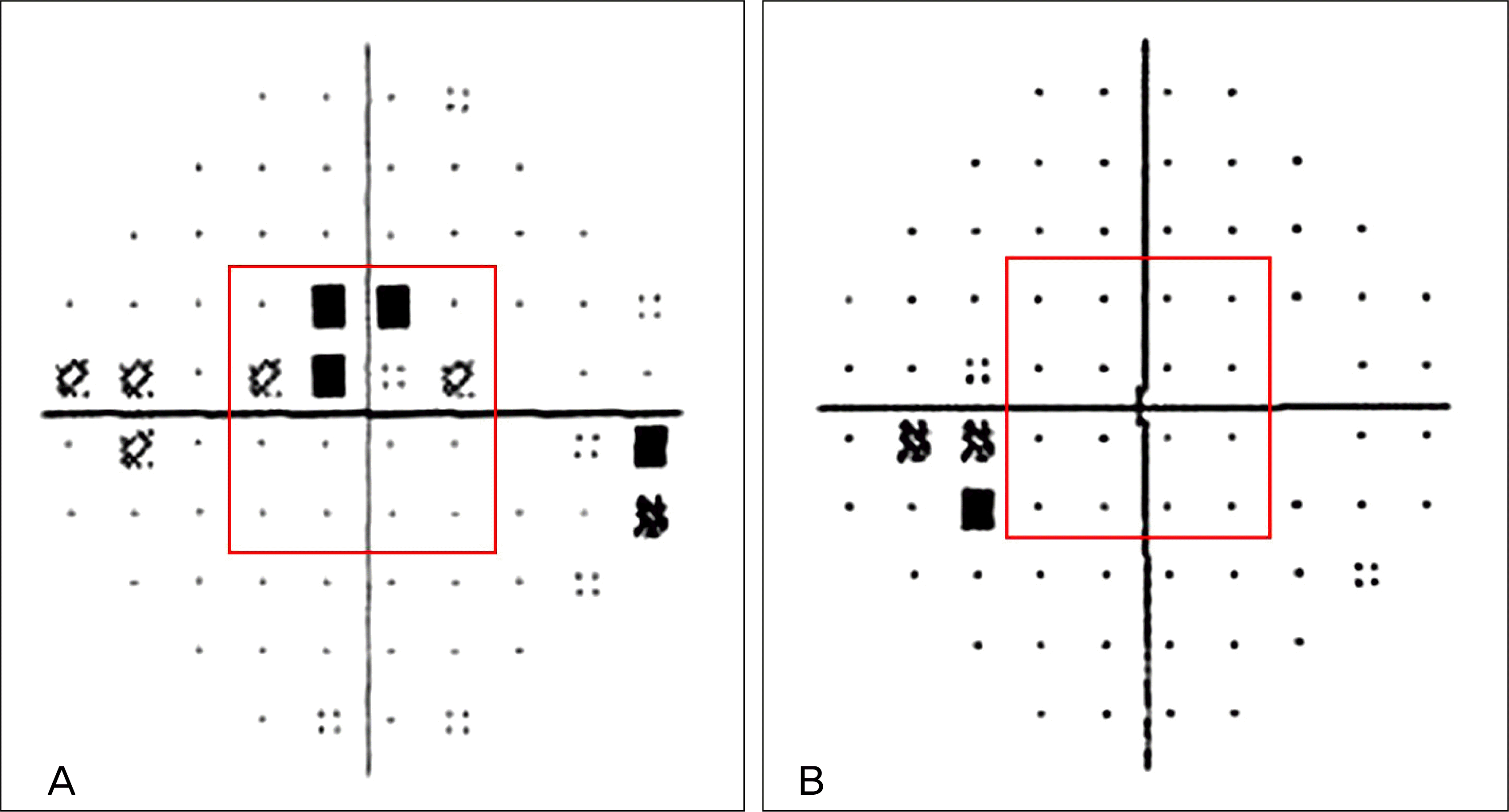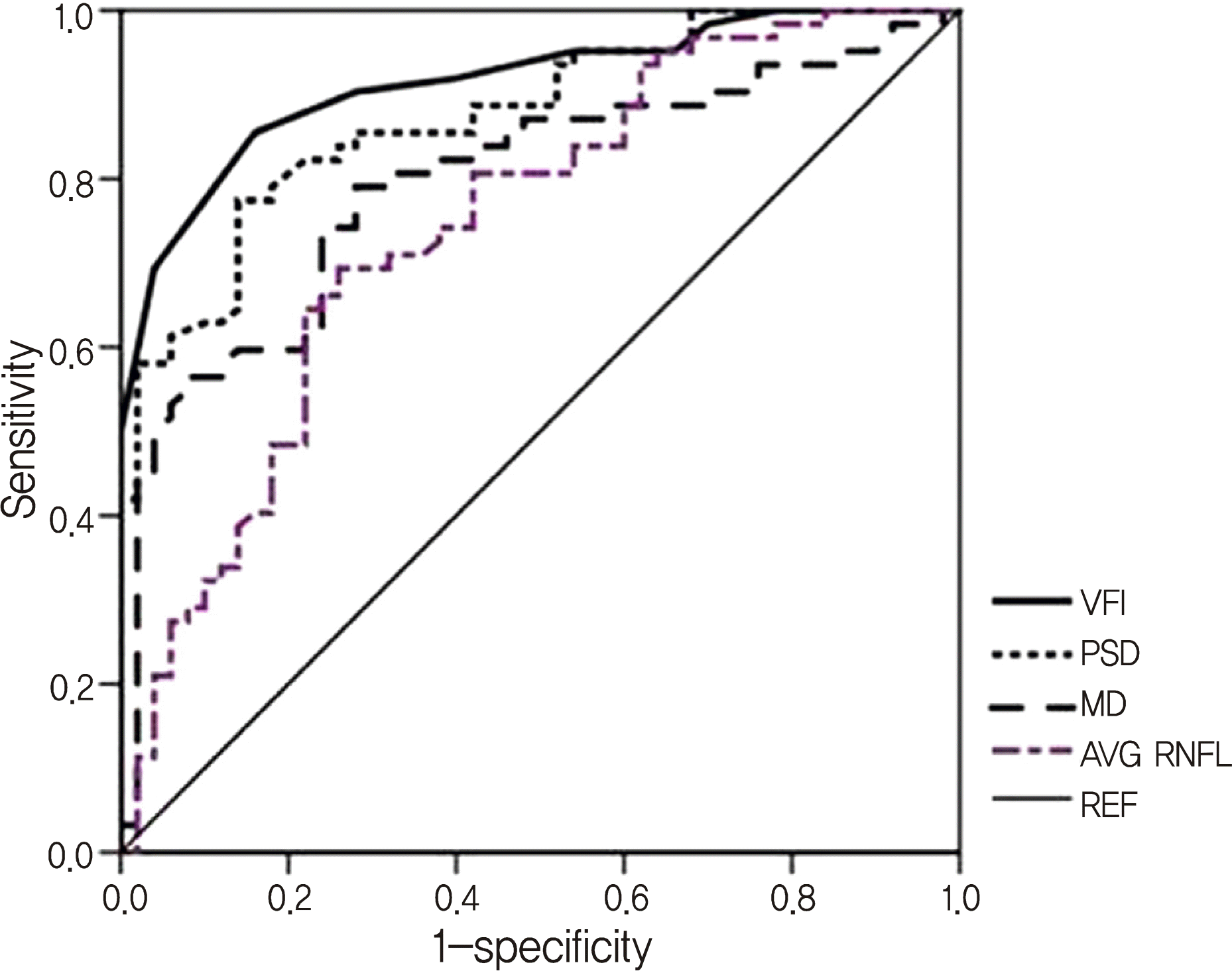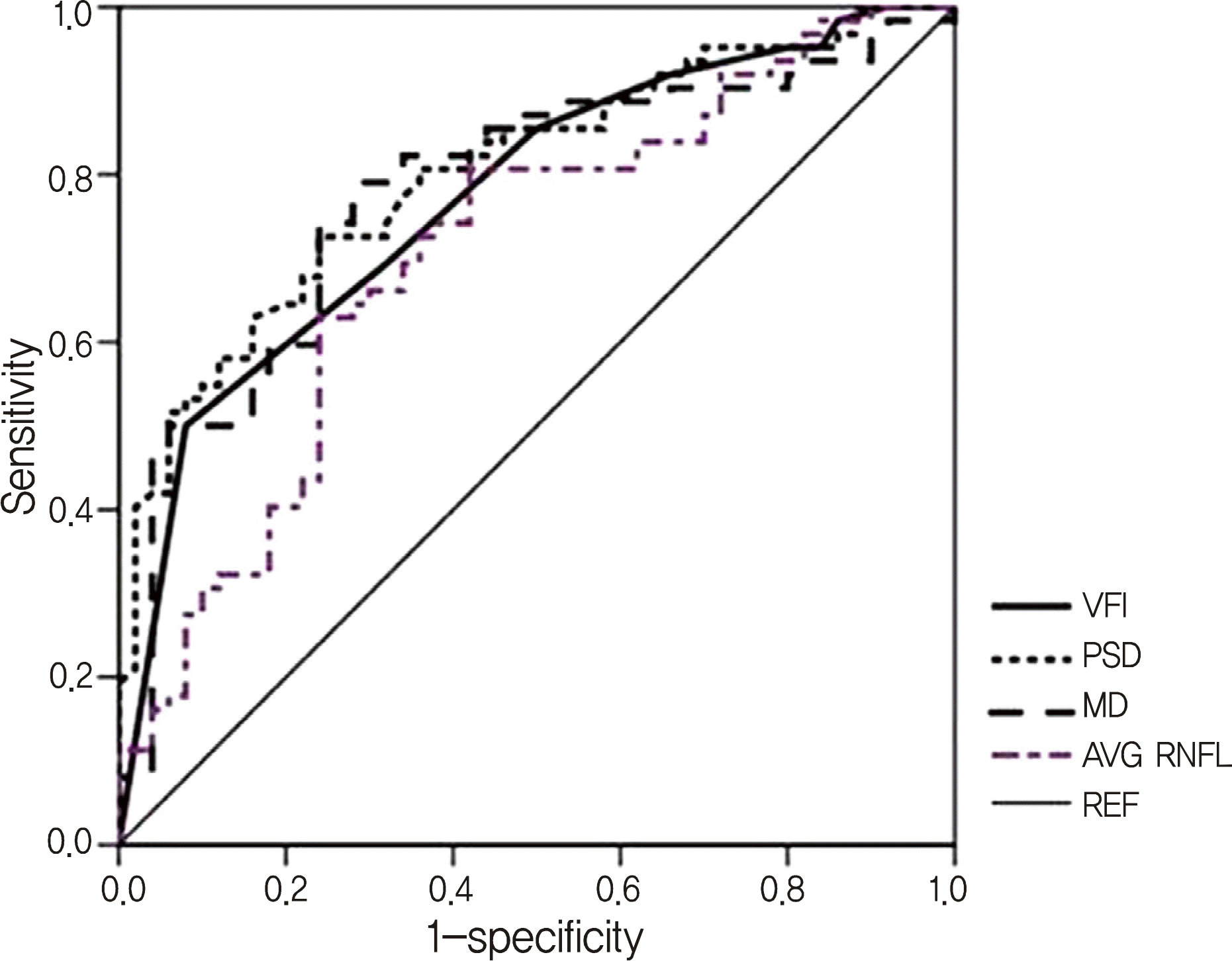Abstract
Purpose
To evaluate the glaucoma discrimination ability of visual field index (VFI), a new perimetric index of Humphrey field analyzer II, in glaucoma patients with central and peripheral visual field defects (VFD).
Methods
Humphrey visual field test and OCT were performed in 204 glaucomatous eyes and 70 healthy eyes. The associations of VFI with mean deviation (MD), pattern standard deviation (PSD), and average retinal nerve fiber layer thickness (RNFLT) were analyzed using Pearson's correlation. The diagnostic abilities of the parameters were analyzed using the areas under the receiver operating characteristic curves (AUROC). The AUROC were compared between MD-matched patients with central VFD (at least one point with p < 1% within the central most 16 points of 30-2 SITA standard automated visual field) and peripheral VFD (VFD beyond the central most 16 points of 30-2 SITA standard automated visual field).
Results
The associations between analyzed parameters and VFI were statistically significant. The MD, RNFLT, age, intraocular pressure, and central cornea thickness were not different between the two groups (p > 0.05). The AUROC value of VFI was greater than those of the MD and average RNFLT but was not different from that of PSD (p = 0.332) in the central VFD group. However, there were no significant differences between AUROC value of VFI and those of other parameters in the peripheral VFD group (all, p > 0.05).
Go to : 
References
1. Sommer A, Miller NR, Pollack I, et al. The nerve fiber layer in the diagnosis of glaucoma. Arch Ophthalmol. 1977; 95:2149–56.

2. Cho CH, Kee CW. Association of retinal nerve fiber layer thickness measured by optical coherence tomography and automatic perimetry. J Korean Ophthalmol Soc. 2002; 43:1032–9.
3. Quigley HA, Dunkelberger GR, Green WR. Retinal ganglion cell atrophy correlated with automated perimetry in human eyes with glaucoma. Am J Ophthalmol. 1989; 107:453–64.

4. Sommer A, Katz J, Quigley HA, et al. Clinically detectable nerve fiber atrophy precedes the onset of glaucomatous field loss. Arch Ophthalmol. 1991; 109:77–83.

5. Heijl A, Lindgren G, Olsson J. A package for the statistical analy-sis of visual fields. Doc Ophthalmol Proc Ser. 1987; 49:153–68.

6. Bengtsson B, Heijl A. A visual field index for calculation of glaucoma rate of progression. Am J Ophthalmol. 2008; 145:343–53.

7. Lima VC, Prata TS, De Moraes CG, et al. A comparison between microperimetry and standard achromatic perimetry of the central visual field in eyes with glaucomatous paracentral visual-field defects. Br J Ophthalmol. 2010; 94:64–7.

8. Flammer J. Fluctuations in the visual fields. Drance SM, Anderson DR, editors. Automatic Perimetry in Glaucoma. A Practical Guide, New ed. Orlando, FL: Grune and Stratton Inc.;1985. 1:chap. 7.
9. Asman P, Heijl A. Diffuse visual field loss and glaucoma. Acta Ophthalmol. 1994; 72:303–8.
10. Chauhan BC, LeBlanc RP, Shaw AM, et al. Repeatable diffuse visual field loss in open-angle glaucoma. Ophthalmology. 1997; 104:532–8.

11. Weber JT. Topographie der Funktionellen Schädigung Beim Chronishen Glaukom, New ed. Heidelberg, Germany: Kauden Verlag. 1992; 81.
12. Asman P, Wild JM, Heijl A. Appearance of the pattern deviation map as a function of change in area of localized field loss. Invest Ophthalmol Vis Sci. 2004; 45:3099–106.
Go to : 
 | Figure 1.Visual field tests of central and peripheral visual field defect (VFD) groups. (A) Central VFD group. (B) Peripheral VFD group. |
 | Figure 2.ROC curve of central VFD group. ROC = receiver operating characteristics; VFD = visual field defect; VFI = visual field index; PSD = pattern standard deviation; MD = mean deviation; AVG RNFL = average retinal nerve fiber layer thickness; REF = reference line. |
 | Figure 3.ROC curve of peripheral VFD group. ROC = receiver operating characteristics; VFD = visual field defect; VFI = visual field index; PSD = pattern standard deviation; MD = mean deviation; AVG RNFL = average retinal nerve fiber layer thickness; REF = reference line. |
Table 1.
Comparison of glaucoma group and control group
| Glaucoma group (n = 204) | Control group (n = 70) | p-value | |
|---|---|---|---|
| Age (mean ± SD, yr) | 53.57 ± 14.79 | 47.00 ± 13.28 | 0.285* |
| Sex (M/F) | 99/105 | 35/35 | 0.470† |
| BCVA (mean ± SD, logMAR) | 0.85 ± 0.180 | 0.91 ± 0.146 | 0.008‡ |
| CCT (mean ± SD, μ m) | 539.49 ± 38.467 | 541.25 ± 36.32 | 0.924* |
| IOP (mean ± SD, mm Hg) | 15.41 ± 4.69 | 15.40 ± 5.45 | 0.295* |
| MD (mean ± SD, dB) | −5.72 ± 5.32 | −1.57 ± 1.97 | <0.001* |
| PSD (mean ± SD, dB) | 5.64 ± 4.28 | 2.12 ± 1.47 | <0.001* |
| VFI (mean ± SD, %) | 87.60 ± 16.48 | 98.53 ± 3.05 | <0.001* |
| Average RNFL thickness (mean ± SD, μ m) | 86.99 ± 16.45 | 102.68 ± 13.23 | 0.021* |
Table 2.
Correlation of visual field index with other parameters in glaucoma patients
| Correlation coefficient | p-value* | |
|---|---|---|
| MD (dB) | 0.953 | <0.001 |
| PSD (dB) | 0.841 | <0.001 |
| Average RNFL thickness (μ m) | 0.503 | <0.001 |
Table 3.
Comparison of central VFD group and peripheral VFD group
| Central VFD group (n = 50) | Peripheral VFD group (n = 50) | p-value | |
|---|---|---|---|
| Age (mean ± SD, yr) | 52.10 ± 15.80 | 52.12 ± 13.51 | 0.291* |
| Sex (M/F) | 29/21 | 25/25 | 0.422† |
| BCVA (mean ± SD, logMAR) | 0.83 ± 0.182 | 0.87 ± 0.185 | 0.169‡ |
| CCT (mean ± SD, μ m) | 539.88 ± 34.32 | 532.79 ± 28.54 | 0.225* |
| IOP (mean ± SD, mm Hg) | 15.94 ± 4.53 | 15.12 ± 5.53 | 0.518* |
| MD (mean ± SD, dB) | −2.89 ± 1.26 | −2.88 ± 1.31 | 0.661* |
| PSD (mean ± SD, dB) | 4.08 ± 2.25 | 3.21 ± 1.82 | 0.020* |
| VFI (mean ± SD, %) | 93.82 ± 4.01 | 96.40 ± 3.31 | 0.253* |
| Average RNFL thickness (mean ± SD, μ m) | 91.15 ± 15.61 | 93.53 ± 11.98 | 0.199* |
| Superior RNFL thickness | 111.20 ± 22.325 | 112.10 ± 21.17 | 0.669* |
| Nasal RNFL thickness | 73.68 ± 19.15 | 73.60 ± 5.22 | 0.076* |
| Inferior RNFL thickness | 108.84 ± 27.53 | 116.32 ± 19.75 | 0.197* |
| Temporal RNFL thickness | 70.94 ± 16.07 | 72.12 ± 13.65 | 0.509* |
Table 4.
The area under receiver operating curve (AUROC) of the parameters from humphrey visual field and from OCT in both groups
|
AUROC |
p-value for difference from VFI* |
|||
|---|---|---|---|---|
| Central VFD group | Peripheral VFD group | Central VFD group | Peripheral VFD group | |
| MD (dB) | 0.796 | 0.781 | 0.018 | 0.886 |
| PSD (dB) | 0.875 | 0.802 | 0.332 | 0.618 |
| VFI (%) | 0.915 | 0.772 | NA | NA |
| Average RNFL thickness (μ m) | 0.744 | 0.706 | 0.015 | 0.322 |




 PDF
PDF ePub
ePub Citation
Citation Print
Print


 XML Download
XML Download